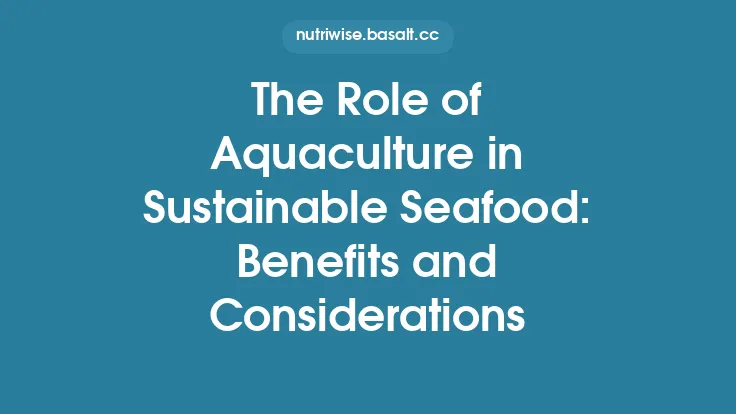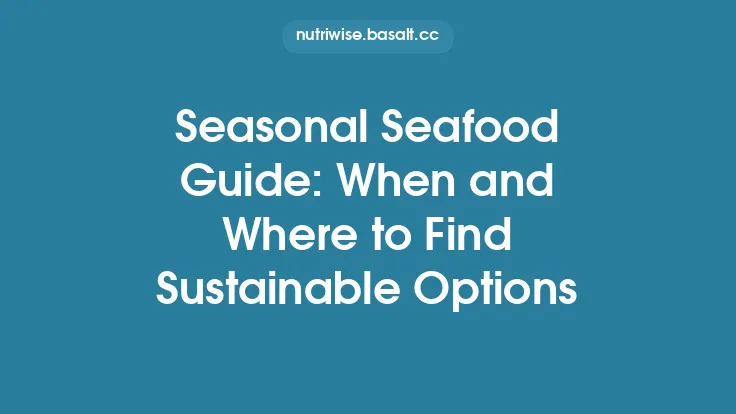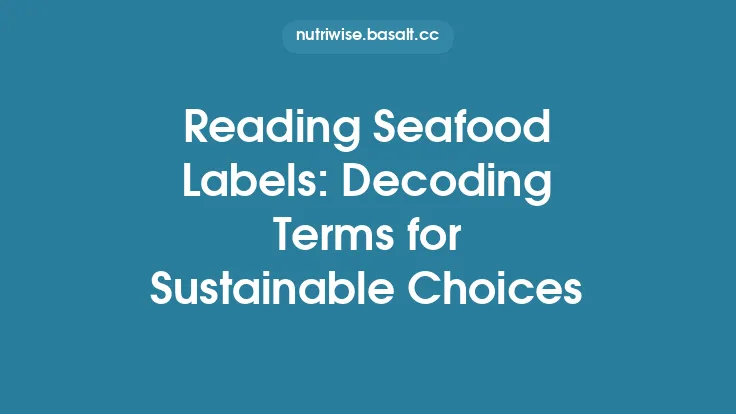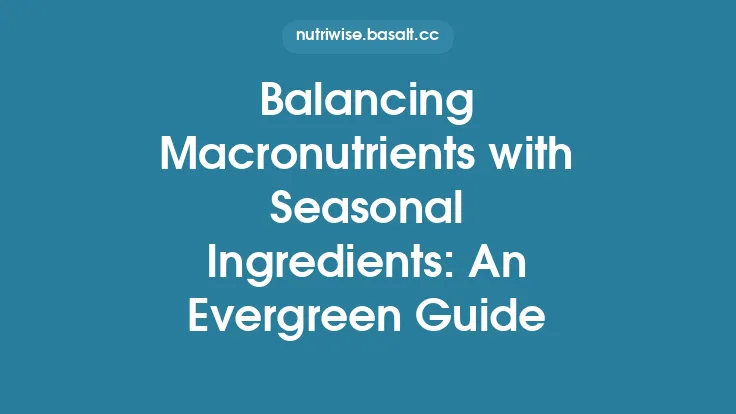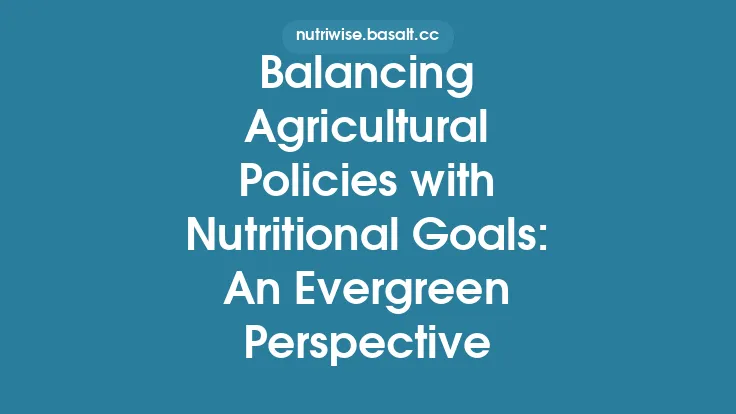Omega‑3 fatty acids—particularly eicosapentaenoic acid (EPA) and docosahexaenoic acid (DHA)—have become synonymous with heart‑healthy, brain‑supporting nutrition. Their reputation for reducing inflammation, supporting visual development, and lowering the risk of chronic disease has driven a surge in consumer demand for seafood that delivers these nutrients. Yet the very species prized for their high EPA/DHA content often sit at the center of ecological debates about overfishing, habitat degradation, and carbon footprints.
Finding a balance between reaping the health benefits of omega‑3s and protecting marine ecosystems requires more than simply picking the “most popular” fish on the menu. It calls for an understanding of the biochemistry of these fats, an awareness of the environmental costs associated with different harvesting methods, and a set of practical criteria that guide sustainable purchasing decisions. The following sections explore each of these dimensions, offering a comprehensive roadmap for anyone who wants to enjoy omega‑3‑rich seafood without compromising the planet’s long‑term health.
Understanding Omega‑3 Fatty Acids and Their Health Benefits
Biochemical profile
EPA (20:5n‑3) and DHA (22:6n‑3) are long‑chain polyunsaturated fatty acids (LC‑PUFAs) that differ from the shorter‑chain alpha‑linolenic acid (ALA, 18:3n‑3) found in many plant foods. While the human body can convert ALA to EPA and DHA, the conversion efficiency is notoriously low—often less than 5 % for EPA and under 2 % for DHA—making direct dietary sources of the long‑chain forms essential for optimal health outcomes.
Cardiovascular protection
Clinical trials and meta‑analyses consistently show that regular intake of EPA/DHA reduces triglyceride levels, modestly lowers systolic blood pressure, and improves endothelial function. The anti‑arrhythmic properties of DHA, in particular, are linked to a decreased incidence of sudden cardiac death.
Neurodevelopment and cognition
DHA is a major structural component of neuronal membranes and retinal photoreceptors. Adequate DHA intake during pregnancy and early childhood correlates with improved visual acuity and cognitive performance. In adults, higher DHA status is associated with slower age‑related cognitive decline and a reduced risk of neurodegenerative diseases.
Inflammation and immune modulation
Both EPA and DHA give rise to specialized pro‑resolving mediators (SPMs) such as resolvins, protectins, and maresins. These molecules actively terminate inflammatory cascades, offering therapeutic potential for conditions ranging from rheumatoid arthritis to inflammatory bowel disease.
The Environmental Footprint of Common Omega‑3 Rich Seafood
Wild‑caught pelagic species
Species such as mackerel, sardines, and herring are among the most efficient natural sources of EPA/DHA. They occupy lower trophic levels, have rapid growth rates, and reproduce in large numbers, resulting in relatively low per‑kilogram carbon emissions and modest ecosystem disturbance when harvested responsibly.
Large predatory fish
Tuna, salmon (wild), and swordfish accumulate high concentrations of omega‑3s because they feed higher up the food chain. However, their longer lifespans and slower reproductive cycles make them more vulnerable to overexploitation. The energy required to capture these species—often involving fuel‑intensive longline or purse‑seine vessels—adds to their carbon footprint.
Farmed salmon
Aquaculture has become a dominant source of farmed Atlantic salmon, a fish celebrated for its EPA/DHA content. Modern recirculating‑aquaculture systems (RAS) can achieve high feed conversion ratios, but traditional net‑pen operations rely heavily on fishmeal and fish oil derived from wild forage fish, creating indirect pressure on lower‑trophic marine stocks. Additionally, nutrient runoff and disease management pose localized environmental challenges.
By‑product utilization
A significant portion of the omega‑3 market is supplied by fish oil extracted from processing by‑products (heads, frames, viscera). While this practice adds value to waste streams, the sustainability of the primary catch remains a critical factor; high‑by‑product yields do not offset unsustainable harvesting of the source species.
Criteria for Sustainable Omega‑3 Seafood Selection
- Trophic level and life‑history traits
- Prioritize species that occupy lower trophic levels (e.g., sardines, anchovies) and exhibit fast growth, early maturity, and high fecundity. These traits generally indicate a greater capacity for population resilience.
- Harvest method impact
- Purse‑seine with fish‑aggregating devices (FADs) can increase by‑catch and habitat damage; avoid unless the fishery demonstrates proven mitigation measures.
- Pole‑and‑line and hand‑line fisheries typically have minimal by‑catch and lower fuel consumption, making them preferable for species like tuna and mackerel.
- Geographic and ecosystem context
- Some regions have robust management frameworks (e.g., the North Atlantic for herring) that enforce quotas, seasonal closures, and ecosystem‑based assessments. Selecting seafood from well‑governed fisheries reduces the risk of contributing to ecosystem imbalance.
- Feed composition in aquaculture
- Look for farmed fish raised on diets that incorporate alternative omega‑3 sources (e.g., algal oil, insect protein) rather than relying heavily on wild‑caught fishmeal. This reduces pressure on forage fish stocks and improves the overall sustainability profile.
- Carbon and energy considerations
- While not the primary focus of most sustainability certifications, life‑cycle assessments (LCAs) reveal that short‑haul, low‑fuel capture methods and land‑based recirculating systems tend to have lower greenhouse gas emissions per gram of EPA/DHA delivered.
Balancing Nutrient Density with Ecosystem Health
Nutrient density metrics
When comparing species, consider the ratio of EPA + DHA to the environmental impact indicator (e.g., carbon footprint, fishing mortality rate). For instance, a 100‑gram serving of sardines may provide 1,200 mg of EPA/DHA with a carbon footprint of ~0.5 kg CO₂e, whereas the same amount of farmed Atlantic salmon could deliver a comparable omega‑3 dose but with a higher footprint (~2 kg CO₂e) due to feed production and energy use.
Portfolio approach
Rather than relying on a single “super‑fish,” diversify omega‑3 intake across multiple sustainable sources. This spreads ecological pressure, reduces the risk of over‑reliance on any one stock, and ensures a broader spectrum of micronutrients (e.g., selenium in sardines, vitamin D in herring).
Seasonality and local abundance
Even within sustainable fisheries, seasonal peaks in spawning can affect stock health. Aligning purchases with periods of natural abundance—when fish are more plentiful and less likely to be harvested under restrictive quotas—helps maintain population stability.
Alternative Sources of EPA/DHA: From Algae to Fortified Foods
Algal oil
Microalgae are the primary producers of EPA and DHA in marine food webs. Commercially cultivated strains (e.g., *Schizochytrium* spp.) can be harvested in closed‑system bioreactors, yielding a vegan‑friendly, traceable source of long‑chain omega‑3s. Algal oil typically has a lower environmental impact than fish oil because it bypasses the need for wild‑catch feedstock.
Genetically engineered oilseeds
Recent advances have enabled the production of EPA/DHA in camelina, canola, and soybean seeds through metabolic pathway engineering. These crops can be cultivated on existing agricultural land, offering a scalable, land‑based omega‑3 source that integrates with existing food supply chains.
Fortified animal products
Eggs, dairy, and poultry can be enriched with EPA/DHA by incorporating algal or fish oil into animal feed. While the sustainability of the feed ingredient remains a consideration, the resulting products provide a familiar dietary format for consumers who may be reluctant to eat fish.
Supplements and functional foods
Capsules, gummies, and fortified beverages derived from algal oil present a convenient way to meet EPA/DHA recommendations without direct seafood consumption. When selecting supplements, verify that the production process adheres to recognized environmental standards (e.g., low‑energy extraction, minimal solvent use).
Practical Tips for Making Sustainable Omega‑3 Choices
- Ask about the catch method: When dining out or buying from a fishmonger, inquire whether the fish was caught using pole‑and‑line, hand‑line, or a low‑by‑catch method.
- Prioritize lower‑trophic species: Incorporate sardines, herring, anchovies, and mackerel into weekly meal plans; they are both nutrient‑dense and generally more sustainable.
- Choose responsibly farmed salmon: Look for farms that publish feed composition data showing reduced reliance on wild fishmeal and that employ closed‑containment or recirculating systems.
- Rotate omega‑3 sources: Alternate between wild‑caught fish, responsibly farmed fish, and algal‑based products to diversify intake and reduce pressure on any single resource.
- Mind portion size: A 3‑ounce (85 g) serving of oily fish provides the recommended 250–500 mg of EPA/DHA. Consuming this amount 2–3 times per week meets most health guidelines without excessive demand on fisheries.
- Support transparent supply chains: Purchase from retailers that provide traceability information (e.g., vessel name, fishing area, harvest date). Transparency often correlates with better stewardship practices.
Monitoring and Future Directions in Sustainable Omega‑3 Supply
Emerging certification schemes
Beyond traditional eco‑label programs, new initiatives are evaluating the full life‑cycle carbon intensity of omega‑3 production, integrating both capture and aquaculture metrics. Monitoring the adoption of these schemes can guide consumers toward the most climate‑conscious options.
Advances in feed technology
Research into insect‑derived proteins, single‑cell proteins, and fermented oils promises to further decouple aquaculture from wild forage fish. As these alternatives become commercially viable, the sustainability profile of farmed omega‑3 sources will improve dramatically.
Policy and management
Effective fisheries management—through science‑based quotas, ecosystem‑based approaches, and international cooperation—remains the cornerstone of long‑term omega‑3 availability. Advocacy for stronger governance, especially in high‑risk regions, helps safeguard both human health and marine biodiversity.
Consumer education and behavior change
Continued public outreach that links personal health benefits to planetary stewardship can shift demand toward sustainable omega‑3 choices. Interactive tools (e.g., carbon calculators for seafood) and clear, science‑backed messaging empower shoppers to make informed decisions.
Research gaps
While the health advantages of EPA/DHA are well documented, more longitudinal studies are needed to quantify the health outcomes of consuming omega‑3s from alternative sources (algal oil, fortified foods) compared with traditional fish. Likewise, comprehensive LCAs that integrate nutrient density, ecosystem impact, and socioeconomic factors will refine the criteria for truly sustainable omega‑3 nutrition.
By weaving together an understanding of omega‑3 biochemistry, a critical appraisal of environmental footprints, and a set of actionable selection criteria, consumers can enjoy the profound health benefits of these essential fats while contributing to the resilience of the world’s oceans. The path forward is not about choosing between health and sustainability—it is about integrating both into a coherent, evidence‑based dietary strategy.
